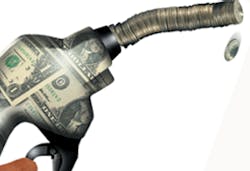Oil prices settled down this morning but didn’t erase the $2.22 surge for a barrel of crude oil to $76.98 yesterday after BP PLC decided to shut down an Alaskan field that comprises of 8% of U.S. crude oil production and just over 2% of U.S. daily oil consumption. Meanwhile energy experts say that in spite of the recent oil shortfall, ultra low sulfur diesel in on track to be available at most pumps by the Oct. 15 deadline.
For the immediate term, the near-record high in crude oil prices will keep diesel and gasoline prices strong nationwide for the next couple of weeks. In the West Coast, wholesale diesel prices were up “by a fair amount” yesterday, according to an Oil Price Information Service (OPIS) official. Refiners in the Pacific Northwest are at the epicenter of the supply shortfall from Alaska.
“In California you’d be surprised how many refiners weaned themselves off of Alaskan North Slope (ANS) crude oil,” Denton Cinquegrana, markets editor for OPIS told FleetOwner. “It’s used mostly by Pacific Northwest refiners, so if we see an impact on refiners, it’d be there before anywhere.”
But energy experts are confident that refiners on the West Coast will be able to make up the oil shortfall by importing and diverting shipments to the region.
“There’ll be a little bit of scrambling involved but when the refined product is selling at tremendous margins, anything is possible,” Cinquegrana said. He described the $2.22 jump in crude oil as “knee-jerk” trading. “There’s a lot of market psychology involved. Prices were down a little bit this morning, so while it’s not continuing to roll higher, it’s not giving back all that it gained either.”
John Taracha, Lubrizol product manager with the diesel fuel additives group, told FleetOwner that he doesn’t foresee the ANS disruption having a significant impact on the transition to ULSD.
“The only thing I see is the typical cascade effect: with less crude there will be proportionally a little less gasoline and diesel produced,” Taracha told FleetOwner. “So there will be a little less on the yield.
“In terms of ULSD throughout the distribution system, it’s my understanding that everything has been going very well. September is the target for all terminals [to have ULSD], and it’s our understanding that it will occur,” Taracha continued. “We’ve been getting samples from different terminals and the fuel samples have been ULSD—over 95% of them.”
With the distribution channels ready to distribute ULSD, the success of the transition now hinges on whether or not energy companies can obtain ample supplies of ultra-low sulfur kerosene to blend with diesel for winter-grade fuel.
“A lot of fuel blenders in the past used kerosene to help winterize their diesel,” Taracha said. “Ultra-low sulfur kerosene will be relatively unavailable and notably pricey. [Trucking companies] should look at their winter operation. This will be the first time winter ULSD will be made in full scale. They shouldn’t assume their operations will run the same way as last winter. You can move diesel around but there will a large demand on short supply. In the northern states in the Midwest rocky regions where it’s cold, the number one concern is that you’re moving from one state to the next and you have to be careful that the fuel you buy is appropriate for the climate.”
To comment on this article, write to Terrence Nguyen at [email protected]
